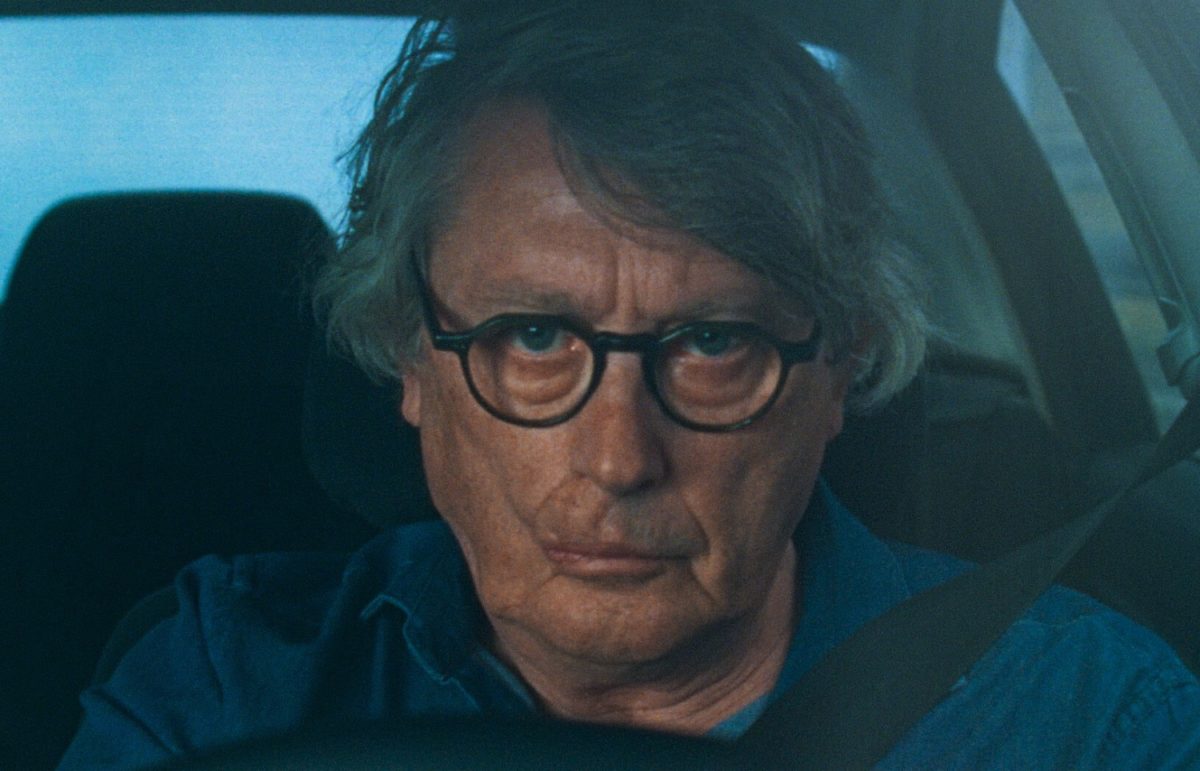Introductions to a Sung Cinema
Musical movies are nearly as old as talking pictures. Indeed, many would credit The Jazz Singer (Alan Crosland, 1927) as the first feature with synchronized sound. Its success secured the reconfiguration of cinema as an audiovisual art form instead of singularly visual. By that same measure, if The Jazz Singer is the talkies’ genesis, it shall also be the musical feature’s most central point of origin (though the genre’s true parents are the theatrical traditions of operetta and revue).
Simply put, the film musical genre has always existed and sometimes thrived in a cinematic paradigm where sound reigns supreme. But, as often happens with forms of popular art that define an era, the musical picture soon became a plaything for artists seeking to disrupt the status quo. Cinematic vanguards have long experimented with the genre as it pertains to realism or the absence of such. Especially during the postwar period and its aesthetic aftershocks, the approximation of cinema to reality became the center of much debate and creativity.
Rather than following the tenets of a dramatic realism whose more modern roots we can trace to 19th-century theater, filmmakers soon discovered and rediscovered methodological paths, technical strategies, and foundations of ideals unto which to build new cinematic monuments about the “real world”. Attempts to approximate what’s on-screen to the material life happening beyond its frame saw the rupture of that porous membrane separating fiction and non-fiction. Documentary technique mingled with narrative, location took the place of the controlled studio once again, and non-professional actors became a usual sight in specific settings. The Italian Neorealists, above most others, pushed the boundaries. They further erected new orders, rules bound to be broken, that would come to inform subsequent vanguards.
In the pursuit of reality, one must first face those monuments that celebrate the illusory. Even such an outlier of vague credulity as the showbiz musical, where the song and dance interludes are often couched in the diegesis, exists in a milieu of demonstrative theatricality. The dominance of fakery is a philosophy shared by all musicals. At the same time, isn’t the pretension of perfect mimesis the greatest fakery of all? By embracing the pinnacle of spectacle, musicals refute any illusion of reality and paradoxically become more real than those works which have mimetic pretensions. This dynamic relates to Baudrillard’s concept of Hyperreality: in specific cultural contexts, the simulacrum of reality, fakeness, and artifice can become more perceptively real than actuality itself. The artificial representation feels closer to what one directly experiences than the thing it purports to represent in the first place. It’s a proto-Brechtian paradox that bestows a quality of unintentional radicalism to even the most conventional product of mass entertainment.
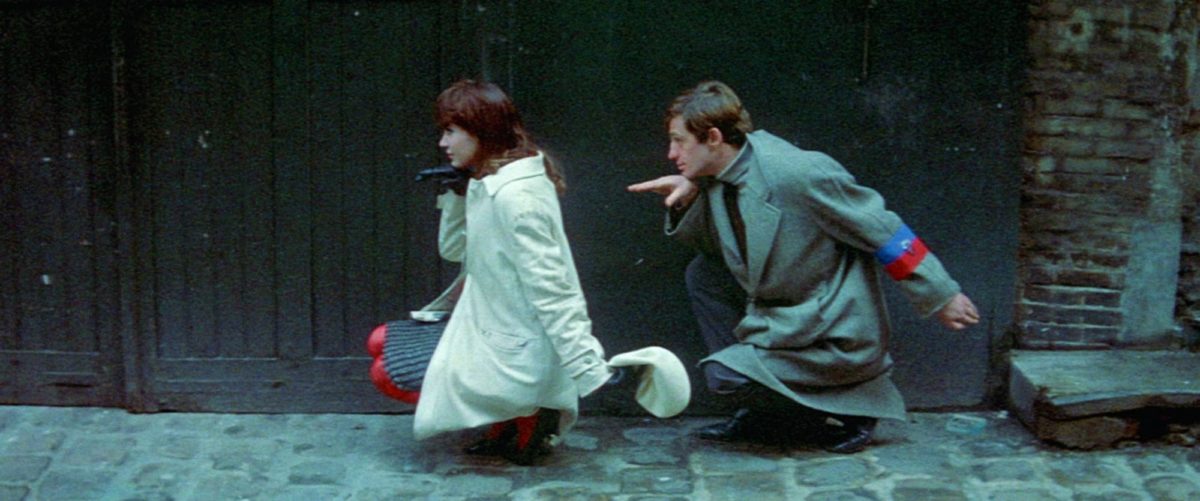
Nouvelle Musical
And so, the neorealist experimentation and the musical’s truthful artifice were bound to draw each other closer, like industrial magnets strong enough to tear down cities in their impetus of attraction. While superficial readings on both filmmaking models may imply they are fundamentally irreconcilable, the truth is more complicated. For ages, their intersection has proven itself a fruitful ground for invention, with Jean-Luc Godard’s Une femme est une femme (A Woman Is a Woman, 1961) as the most famously considered example.
The director himself called it his “first real film” and, along the years, has offered a vast panoply of heterogeneous explanations of the work. Sometimes, Godard describes the project as a response to nostalgia for the musical. However, it can also be seen as a conceptual musical instead of the real deal. Most importantly, for our purposes, Godard also named it a Neorealist musical.
Like Agnès Varda would later do with her L’une chante l’autre pas (One Sings, the Other Doesn’t, 1977), Godard followed the ideals André Bazin popularized in midcentury film criticism and theory. These filmmakers—one from the Right, the other from the Left Bank—made musicals as documents of the now, and both works, as different as they are, prove to be complementing case studies.
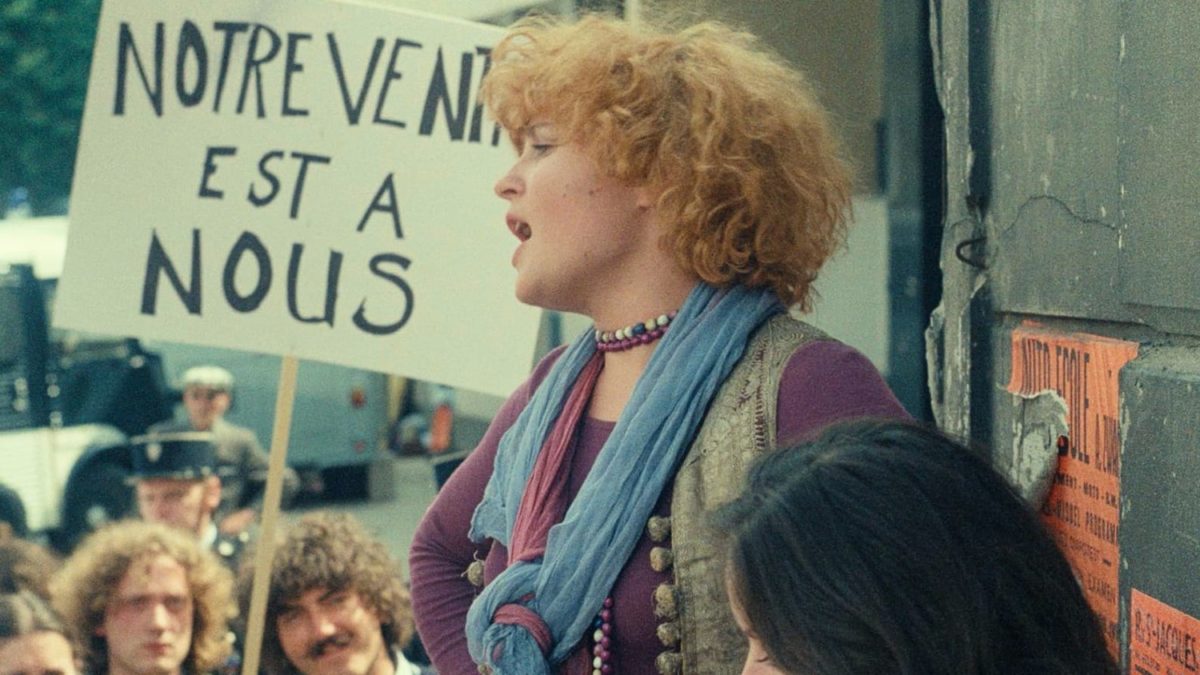
A Woman Is a Woman evokes the feel of a musical by appealing to its characters’ playfulness, the self-aware artifice of their actions. It also uses diegetic music cues superimposed onto unconnected scenes, musicalizing an otherwise realistic interlude. In One Sings, the Other Doesn’t, song is used to articulate inner ideological turmoil and political argumentation, but it always manifests as a theatrical demonstration. The 1977 film is a musical in the same sense that showbiz musicals of the 1930s are. Godard and Varda have couched musical fantasy in a particular conception of silver screen reality that doesn’t repudiate the mimesis of lived experience.
Contrasting them with the exquisite musical extravaganzas of Jacques Demy is instructive. Demy reproduced traditional musical structure, the inorganic burst into song that replaces conversation or self-reflection; Godard and Varda foregrounded contextual details and intensified the friction between the banal quotidian and the folly of musical expression. Colorful lights, proscenium-like compositions, rolling backgrounds and the works dissuade the viewer from ever taking the singing moment as an honest expression of everyday existence. Instead, it’s consistently a performance, a game, a coincidence made into pageantry by the camera’s gaze.
Some of the most successful attempts at realist musicals over the last decades of film history have similarly assumed a Bazinian ethos and further explored a Brechtian foregrounding of artifice. Dancer in the Dark (Lars von Trier, 2000) is an obvious example, seeing as it tries to combine the precepts of Dogme 95 with an idea of musical interludes as flights of fancy, defense mechanisms by which its lead character endures her bleak fate. Another, less lauded example is the proper subject of this essay—Technoboss (João Nicolau, 2019).

A Portuguese Alternative
Portugal’s cinema has a long and rich tradition of musical fiction. Indeed, as it happened in Hollywood with The Jazz Singer, the first Portuguese feature ever produced with synchronized sound was a musical of sorts. Based on the works of playwright Júlio Dantas, A Severa (José Leitão de Barros, 1931) is primarily a documentation of a long-gone way of life, that of poor rural communities and their melancholic song, old customs, old souls. Its title derives from the figure of Maria Severa, a real woman turned into a myth by the movement of history, often misidentified as the sole creator of Portugal’s best-known musical genre, fado.
Fado is an integral part of national artistic identity, Lisbon culture, and has been, as of 2011, in the UNESCO Intangible Cultural Heritage List. Such factors are of considerable importance when one looks at the reality of Portuguese movie musicals from A Severa up to the 1970s. Under a fascistic dictatorship, Portugal’s arts and entertainment were governed with an iron fist by the state. Consequently, such hymns to national tradition as Severa became a model to follow for filmmakers interested in pursuing musical folly outside the theatrical tradition of politically charged revistas (revues). In cinema, stricter censorship meant that no subversion was allowed. For musical movies, only the celebration of the past and the present status quo could prevail. Titles like José Cottinelli Telmo’s A Canção de Lisboa (A Song of Lisbon, 1933) and Francisco Ribeiro’s O Pátio das Cantigas (The Courtyard of the Ballads, 1942) worked as instruments of propagandist exultation.
When the sixties arrived, Portugal was among the national cinemas to go through a rebirth as a new generation of artists proposed revolutionary changes and newfangled experiments, working in opposition to the state-accepted modes of filmmaking. This new wave was partly caused by a culture of illicit underground film clubs that had flourished during the previous decade, disseminating a taste for everything that the Fascist musicals were not. Consequently, the vanguard wasn’t initially too keen on revisiting the genre whose mere existence within the context of Portuguese film history had close political ties to the oppressive regime.See, for instance, Jorge Leitão Ramos’s Dicionário do Cinema Português 1893-2003 (Dictionary of Portuguese Cinema 1893-2003), which discusses how the rise of the Novo Cinema movement coincided with the sudden abandonment of the musical genre.
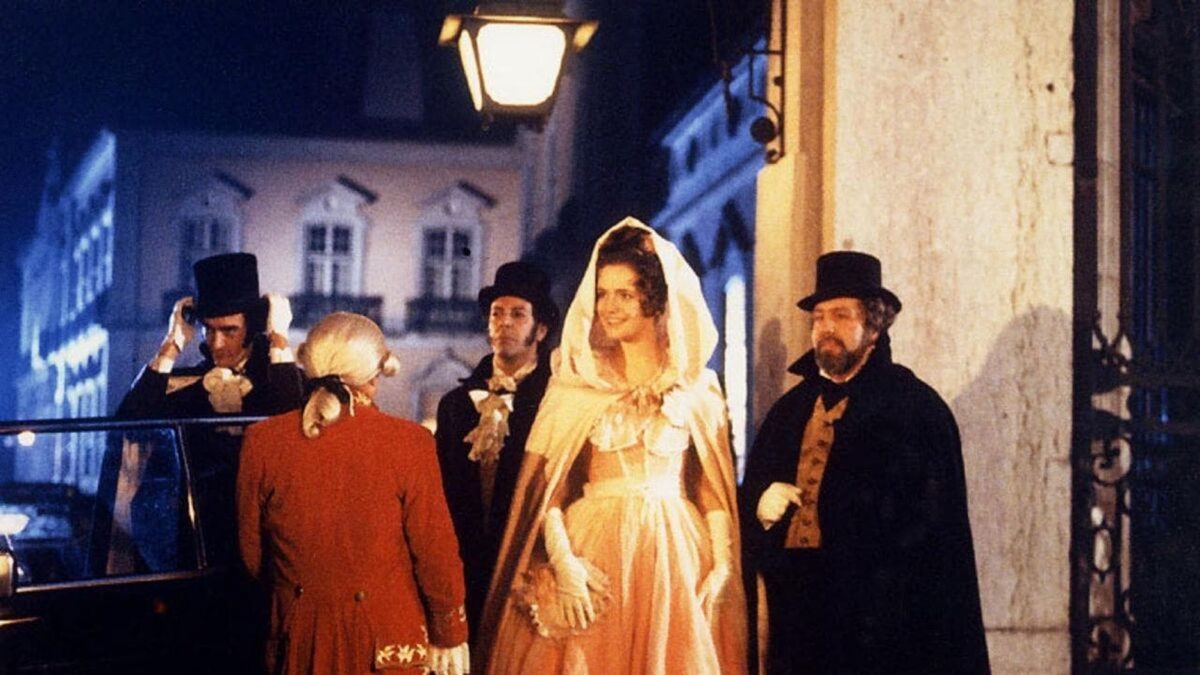
The Carnation Revolution of April 25th, 1974, changed multiple facets of Portuguese life, bringing about a transition into democracy that further affected the evolution of the national cinema. As auteurs gained more creative freedom and the lines between commercial and art film became dogmatic chasms, a willingness to play with overt artifice emerged, eventually flourishing. And with it came a new phase, a distortedly evolved face, of the Portuguese musical. Manoel de Oliveira’s Os Canibais (The Cannibals, 1988), for instance, is the rare opera film that’s not merely a filmed opera. This particular libretto was never performed on stage, having been written specifically for the film. When Manoel de Oliveira adapted Álvaro do Carvalhal’s writings into the shape of a darkly comedic melodrama, he had new music composed by João Paes.
Yet, The Cannibals‘ conception of musical acts on screen is decidedly theatrical. De Oliveira doesn’t record a live production of João Paes’s libretto, but his actors move through the frame in such configurations that make the projected image into a mutating virtual stage. Sometimes performing directly to the camera, inhabiting the real locations through codified gesture and pose, the cast pulls the audience from any sense of immersion. Or maybe it does the opposite. Some of the film’s mechanisms are intrinsically cinematic and defamiliarize the familiar theatricality of opera. Regard an early heated conversation between the two leading players—the camera alternates between looking at them from behind in two-shot and tight closeups. The images play with cinema’s ability to hide and abstract. Despite the room around them being in full swing of waltzing euphoria, we are subsumed into the sung dialogue, and everything else is out of focus, a frenzied mass of amorphous blobs moving to another music we cannot hear. It makes the conversation feel otherworldly, partly because of how the camera can decontextualize a person from their surroundings.
So, again, we return to that treasured precept: if the pretension of reality, the illusion of realism, is inherently dishonest, then unreserved artifice is somehow closer to the truth. The Cannibals never allows the viewer the delusion, however brief, that the film is a document of authentic behavior. The viewer is thus free to face the performer as a performer, to acknowledge them as what they are even within a cinematic space that goes way beyond the limits of traditional theatricality. Furthermore, the actor’s voices aren’t their own, and there’s a narrator who always addresses the camera and comments on the artificial expression the characters indulge in. At one point, this figure mocks the florid melodrama of the language, even while singing in the same style as the people he looks down on.
De Oliveira establishes this film’s Brechtian pseudo-neorealism only to melt it into a boiling wave of insanity by the picture’s end. The Cannibals is about setting an expectation that is then brutally usurped, defiled, devoured with bloodthirsty abandon by men in animal costumes. Despite the apparent layer of fiction, the contract between those who watch and those who are watched is warped out of its usual shape, setting a precedent of unconventional reality and then opening the gates for a surreal coda.
Later, as Portuguese cinema reached the new millennium, more of its creators were outwardly experimenting with this idea—that self-conscious artifice is the key to a paradoxical realism. Even someone like Pedro Costa fits the description.
His Fontainhas films after Ossos (Bones, 1997) start from a rejection of intrusive mechanisms, the tricks of fiction cinema. During the filming of that project, Costa became keenly aware of how disruptive the movie-making apparatus was to the community whose day-to-day existence he tried to portray. The artificial lights felt especially disconnected from the setting, the people. To work against this perceived failure, his next feature, No Quarto da Vanda (In Vanda’s Room, 2000), was shot with only a digital camera and a couple of mirrors. However, from these pared-down docu-fictions, Costa’s films end in the realm of Baroque minimalism with Caravaggio-lite shadows conveying an oneiric quality to Lisbon’s most squalid cityscapes. Circling back to the musical, João Botelho is another filmmaker who’s played with Baroque chiaroscuro and set design concepts that originated in the 17th century. His Filme do Desassossego (Disquiet, 2010), perhaps the director’s lushest production, makes ample use of musical interludes, as does the more recent Peregrinação (Pilgrimage, 2017). That last one returns us to cinema as a political response since Botelho’s period piece merrily spits in the face of those who still glorify ultramarine expansion—an unfortunate perpetuation of imperialist sentiment in Portuguese society.
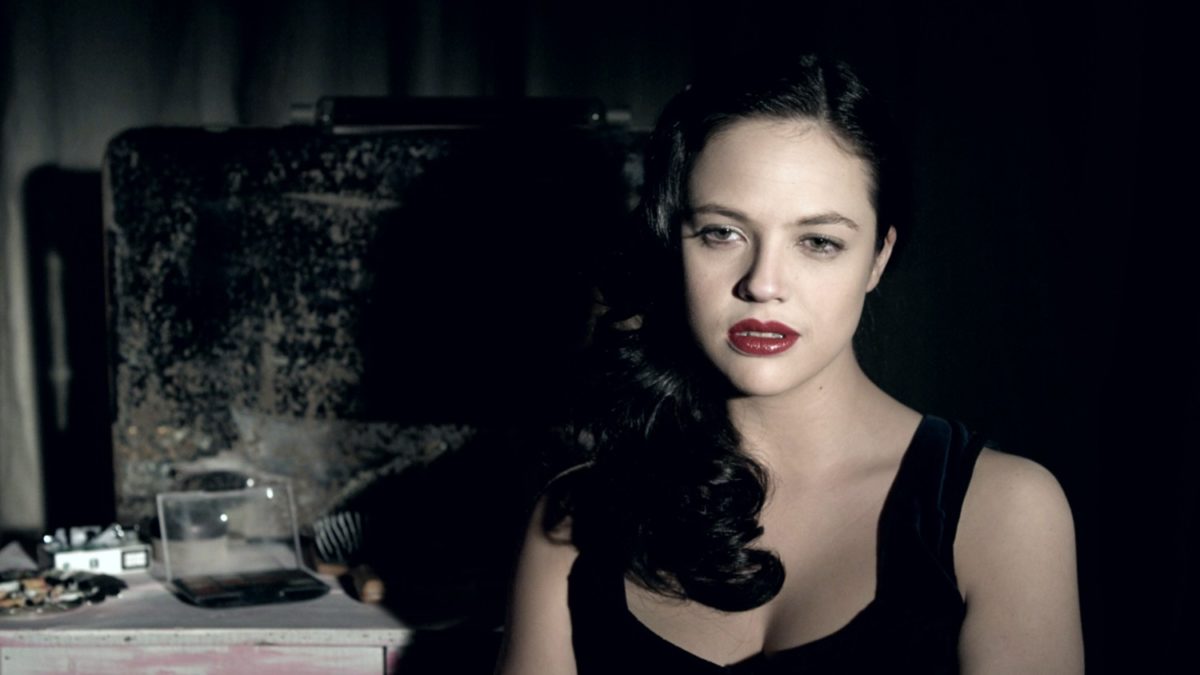
Decades after it was strongly tied to Fascist propaganda, the Portuguese musical has transfigured into an open subversion of nationalistic ideals, negating the idea of the noble worker who endures poverty and achieves happiness through cheerful acquiescence to the status quo as in the 1940s and 1950s propagandist films. Further still, features such as A Fábrica de Nada (The Nothing Factory, Pedro Pinho, 2017) repurpose the musical as the proletariat’s mode of expression. While the genre’s Hollywood origins may be strictly capitalistic, Pinho and other filmmakers have put forward a leftist spin on the model. It comes through in The Nothing Factory‘s narrative—about a workers’ strike—and technique: use of real locations, natural light, an observational overview that uses wide shots to privilege collectivity over individualization, and non-professional actors who could operate the industrial machinery on-screen.

All this brings us to João Nicolau’s third narrative feature in a filmography that includes a panoply of other musical-adjacent projects. It all started with the short film Rapace (Bird of Prey, 2006), where the director indulged in musical interludes in which the people on screen were possessed by a spontaneous need to dance their hearts out. Next, A Espada e a Rosa (The Sword and the Rose, 2010) finds a man escaping from his mundane life to embark on an out-of-time revolutionary journey aboard a 15th-century pirate ship. Sung-through conversations punctuate the urbanite ennui, and the subsequent maritime passages break into interludes of serenading slackerism. At a certain point, to drive home the idea of self-aware artifice, Nicolau has his leading man announce a cut to black before the editing gesture takes place.

That musical was followed by John From (2015), in which tropical daydreams interrupt the stagnant summer of a Portuguese teenager. Just as a flooded balcony beckons an oneiric stagebound beach, so do stray songs produce interludes of musical ecstasy. But, unlike in The Sword and the Rose, John From posits musical-adjacent stylings as isolated flights of fancy that break away from regular life. These experiments were prolonged by Nicolau’s third feature, Technoboss, and its song against obsolescence.
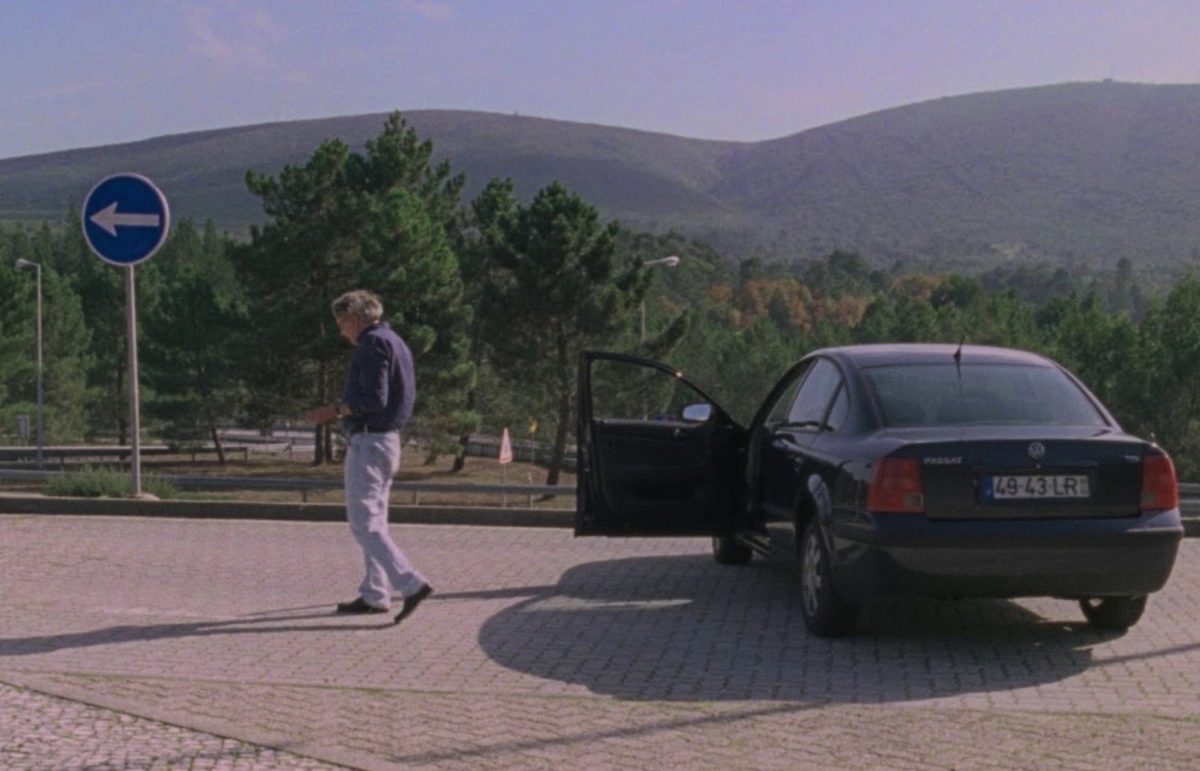
Sound and Fury, Lusitanian-Style
After premiering in the main competition of the 72nd Locarno Film Festival, but before being commercially released, Technoboss closed the 2019 edition of DocLisboa, Portugal’s largest documentary film festival. During a pre-screening introduction, the festival’s organizers defended its suitability to an event putatively dedicated to non-fiction filmmaking. They appealed to the idea that the musical approached the central subject matter through documentary mechanisms like casting non-actors in leading roles, using real-life stories as inspiration, repudiating a cinematic language that hides the seams of its artifice. DocLisboa has long programmed films that defy genre boundaries, works like docudramas that avoid easy categorization.
An idiosyncratic tragicomedy on old age, the film often strikes a tone between the solemn and the parodic. It’s an opera buffa equally fit to cause uncontrollable laughter and despondent tears. The stone-faced introduction gives little away, concentrating, as it does, on the frustrations of Luís Rovisco, a sexagenarian grump waiting by the roadside for assistance with a car that appears to have given up the ghost. Miguel Lobo Antunes, a well-known jurist and cultural figure in Portugal, isn’t a trained actor, and there’s a decided stiltedness to how he inhabits the frame. In some ways, Antunes’s inadaptation to the screen recalls other non-actors’ stylized incursions into Portuguese cinema. One immediately thinks of Pedro Costa’s muses Ventura and Vitalina Varela as examples, though it’s possible to find many other cases across a national cinema that has long embraced the docudrama. Regardless of how he fits within a Portuguese audiovisual tradition, Antunes’s presence is bristling, uncomfortable within the dramatic apparatus of Technoboss.
A sudden ring pulls us away from the abyss of apathy, as does the strange demeanor with which Antunes answers the phone call. The device never appears on-camera, the performer always speaking to the nothingness surrounding him. For a moment, it feels like the invisible phone’s straining alarm will juxtapose a musical façade onto the roadside tableau, prompting a Godardian moment. In A Woman Is a Woman, these incidental sounds often transform casual interactions into musical duets. But then, as soon as it came, it went. It turns out that wasn’t the start of an impromptu song. Instead, it was just the car mechanic apologizing for his delay. In between subsequent scenes of the placid quotidian and boring office antics, the security technician and salesman only reveals his softer side when he’s alone, either behind the wheel or at home with his cat.
And then, while Rovisco drives home at night, non-diegetic music starts twinkling on the soundtrack just as faraway city lights glisten on the horizon. Wordlessly vocalizing his way through the melody, Antunes’s voice strains, and breaks, but there’s beauty to the lonesome tune. A couple of scenes later, he’s back on the road. Finally, it’s the day, and the music returns, coupled with lyrics this time around.
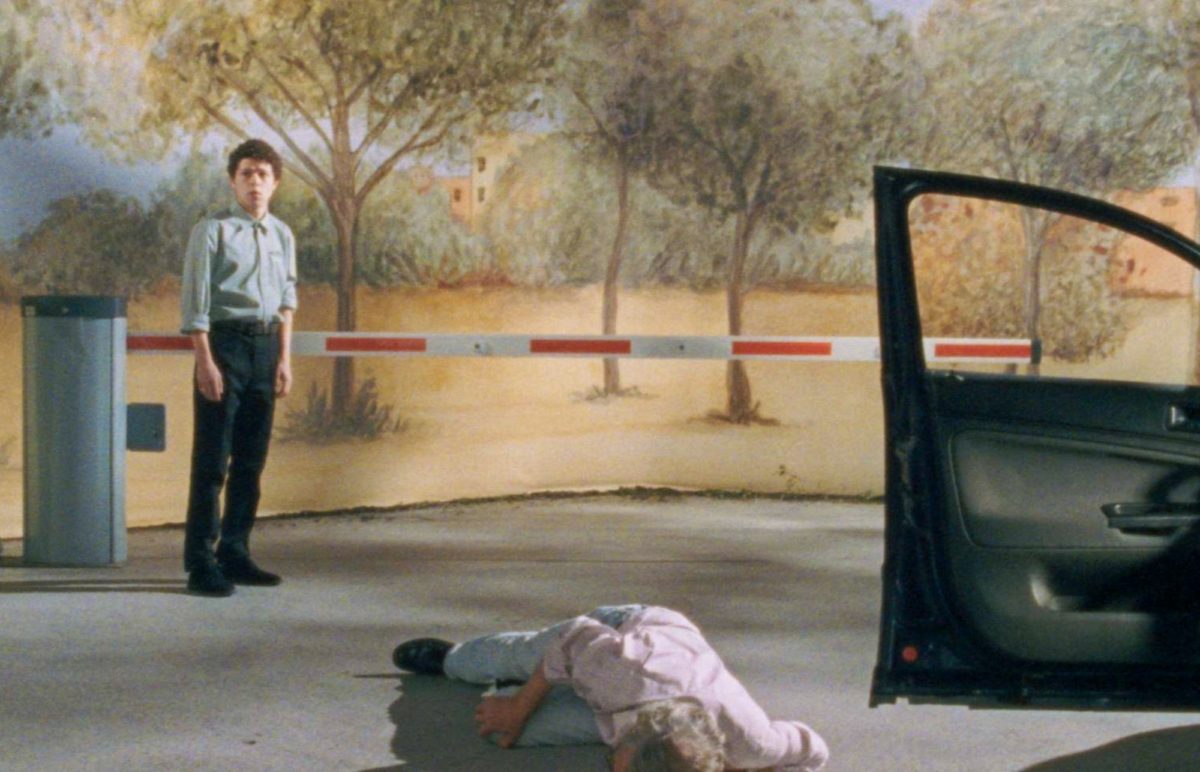
In around 20 minutes of near eventless action, João Nicolau has established a pattern. With every return to the musical mechanism, the director finds increasingly complex devices of self-conscious artifice. First, it’s wordless music, then a driving lullaby. The third musical number reveals a celluloid cosmos, so relentlessly fake one almost feels the need to guffaw out of surprise. Long gone are the roadside landscapes. In their place, painted scrolls appear, long sheets of broad stroke paintings suggesting the vague shape of the outside world. As the car moves forward without moving an inch, the infantile set design simulates its velocity in fits and starts, a primitive solution for a non-problem as, by this point, we’ve seen many scenes of wanderlust driving on location.
The evolving sets are inexorably connected to the musical impulse. Notice that the manifestation of the painted scrolls is always prompted by a song inside the car. There’s only one mournful exception, a moment of such sorrow that the lead character seems to give in to the undercurrent of corrosive melancholy that always travels alongside him. As in most musicals, strong emotions have prompted an interlude of spectacle, introduced by the dry, impersonal description by a heretofore unheard narrator. However, the car doesn’t appear, only a funereal box, resulting in a bizarre dynamic where the set of a road stops representing an actual road, hinting at the metaphorical conception of a transitory passage. The scenography is far from being the only visual element that puts the acknowledgment of artifice at the forefront of the audience’s experience. Cinematographer Mário Castanheira, for instance, works in antithetical extremes, colliding faded images in natural luminescence with abrasive forays into theatrical black box lighting.
A business trip to Spain starts as a travelogue of sunny landscapes until the protagonist crosses the border. In the space of a cut, the visual idioms switch into a paradigm of black voids and harsh spotlights. Furthermore, the 16mm film blesses Technoboss with its characteristically granular texture and tangible sensibility. In the current context we live in, when a filmmaker uses film instead of digital, one must examine how the choice affects the final work. While watching Nicolau’s musical, we’re conscious of the materiality of the picture, its fragility, and the cinematic mechanisms at hand. The Spanish interlude is remarkable in this sense, too, since its contrasting lighting schemes make the grain even more evident. The rounded edges of the frame add to the feel of anachronistic solidity, defining the projected image as a collection of photographs—a quick succession of moving objects rather than some poetic window into another life.
Dramaturgically, the film’s form is also materializing the protagonist’s growing anxieties towards a changing world. For a man who spends his life dealing with stubborn machinery, Rovisco’s a shameless technophobe, preferring everything old-style and as rudimentary as possible. The world is moving ahead and leaving him behind. Instead of running and trying to catch up with the present, the man stands his ground like a mutinous mule. If anything, he prefers to walk backward, away from anything that may challenge the simple order of his days. In Portugal, a country with a rapidly aging population, such themes are remarkably prescient, urgent too, as are Technoboss‘s considerations on how society treats the elderly professionals who must work until they die, either for economic sustenance or their mental peace.
One can easily imagine the same scenario filmed as a miserabilist drama about an older man’s painful self-reflection. An appeal to authenticity could justify such darkness, but that wouldn’t make it any more accessible. Technoboss, on the other hand, is more inviting. There’s a playfulness to its construction. Every new scene opens up to the possibility of some other singing invention. The score by Norberto Lobo, Luís José Martins and Pedro da Silva Martins rarely indulges in one-dimensional ennui. The predominant sound is softly romantic falling into clownish anger, hymns of commonplace observations opening up to a rock and roll screed. It’s indefatigable lunacy, so odd nobody bats an eye when, out of nowhere, ‘The Ketchup Song’ roars its way into the film, frenetic dancing included.
Music also barges into Technoboss as a means of self-expression that can open up to a communal experience. Luís Rovisco’s singing may start as something he does when alone behind the wheel, but it gradually becomes something more multifaceted, a joint exercise rather than the grumblings of a frustrated Scrooge. A beloved grandchild is the first to share a tune with the old man, but an aggrieved coworker is soon to follow. As Technoboss unravels and Nicolau’s game of intensifying theatrics requires more significant levels of artifice, the protagonist finds himself a Greek chorus of sorts. First, it’s a men’s choir Rovisco doesn’t gel with, then a rock and roll act with which he argues, and, finally, a punk band that follows him into the car like a spectral haunting full of misanthropic rage.
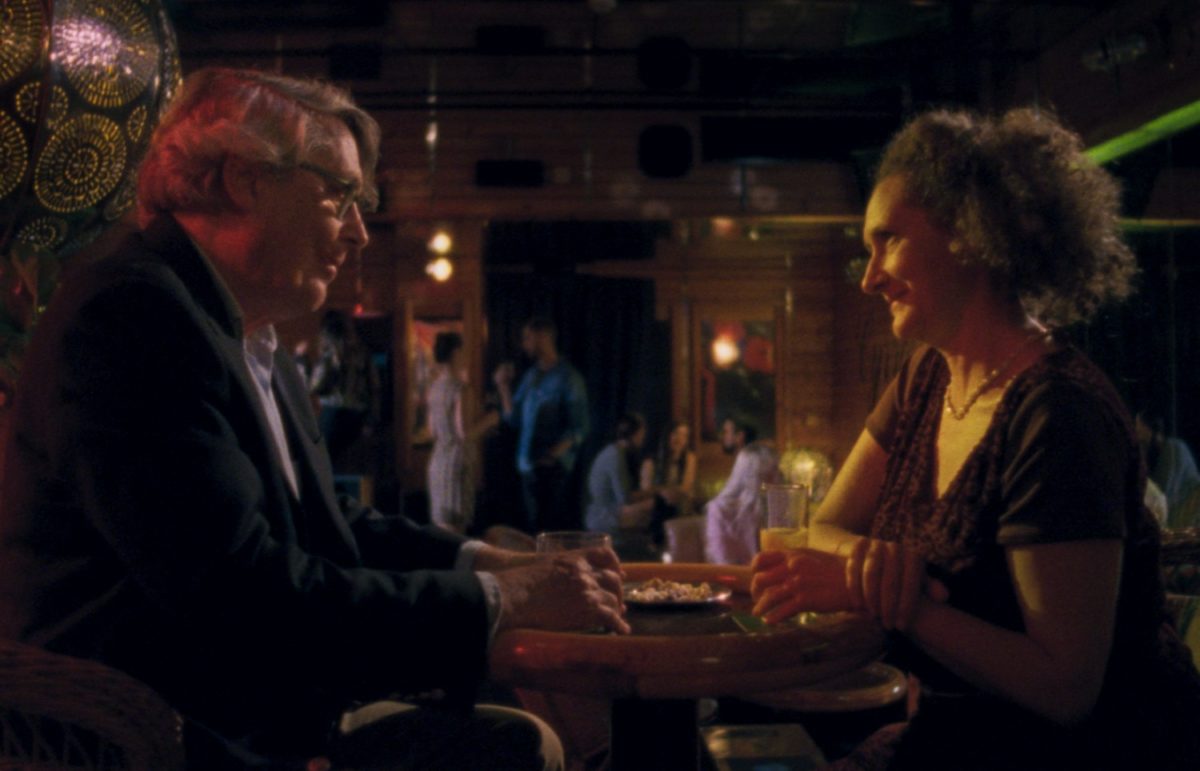
The musical interlude as a cyclical mechanism thus loses its insular properties to become a shared joy. During the film’s lazy climax, the afterglow of two lovers contradicts possible anti-social readings of the earlier songs by repeating past lyrics in a new context of blossoming interpersonal warmth. Even though he’s working with a non-professional actor whose performance is deliberately amateurish, Nicolau manages to trace a broad character evolution of autumnal depression thawing into mutual contentment. The cineaste does this by exteriorizing the protagonist’s interior turmoil, his inner transformations, with song. Despite its oddities and social consciousness, Technoboss is classical in how it uses musical codes to drive a character-focused narrative.
Amid all this, the tuneless singing of most cast members (professional actors besides Lobo Antunes) becomes an integral part of the picture’s concoction of realism by way of falseness. The lack of sonic polish recalls the cast of Demy’s films and even Leos Carax’s Annette (2021) with the laborious singing of Adam Driver and Simon Helberg. This sonic quality also posits the characters’ singing as a form of naïf artistic expression, a gesture that’s always sincere with the disparate feelings it tries to portray. Could we consider that anti-melodious choice as another step in the direction of the musical’s flirtation with Neorealism? Again, the acceptance, the illumination of artifice serves to disarm the audience and bring down the walls between them and the projected image, its proposition of a sung reality where the impossible is commonplace.
Neorealism is about more than just a surface of grubby veracity, dark themes, and darker moods. It’s a cinematic movement with specifically leftist political ideals, an attempt at engaging the audience with a truthful vision of the world rather than an escapist dream. Technoboss fits into those paradigms as a narrative marked by late-in-life anxieties, a sense of technological and existential obsoleteness, capitalist ennui that anchors it in harsh realities. According to interviews, the director tried to keep his story apolitical, but the final product is a rich text of political cinema. All that being said, the musical mechanisms do demand artifice and a certain anti-seriousness. A demand which Nicolau indulges with abrasive fervor, never trying to create a consolidated on-screen universe where singing is natural. Instead, he underlines the fault lines separating the artistic impulses of realism and musical cinema, bringing them together in inverted motion.
Looking at Technoboss‘s road interludes, one feels like Luís Rovisco, who, at a certain point, talks directly to a performing band only for them to answer back in song. Watching the film is to engage in a cinematic conversation. If musicals are lies that tell the truth, the more blatant the lie, the more truthful the truth—the more real it is.
